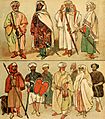Al-Andalus facts for kids
Al-Andalus (Arabic: الأندلس) was the Arabic name given to those parts of the Iberian Peninsula governed by Muslims, or Moors, at various times in the period between 711 and 1492. As a political domain or domains, it was successively a province of the Umayyad Caliphate, the Caliphate of Córdoba (929-1031), and finally the Caliphate of Córdoba's taifa (successor) kingdoms. For large parts of its history, particularly under the Caliphate of Córdoba, Andalus was famous for learning and the city of Córdoba became one of the leading cultural and economic centers in both the Mediterranean basin and the Islamic world.
This civilization was quite advanced at architecture and urban planning. The Moors were very wealthy because they controlled the gold trade from the Ghana Empire in West Africa. They built many beautiful buildings in all the land they controlled. Many of their large buildings still stand in cities in Andalusia, such as in Seville, Granada, and Cordoba.
Muslim Spain was multicultural and comparatively tolerant; Jews, Christians and Muslims lived side by side. There was also a saqaliba population (the descendants of European slaves) near the Mediterranean coast. Though these people were at first brought in to be slaves, some of them became generals (as did some Mamluks in another caliphate) and some generals became rulers of their own cities (taifas) for a short time.
In 1236, the Reconquista (gradual Christian reconquest) under the forces of Ferdinand III of Castile progressed as far as the last remaining Islamic stronghold, Granada. Granada was reduced to a vassal state to Castile for the next 256 years, until January 2, 1492, when Boabdil surrendered complete control of Granada to Ferdinand and Isabella.
Contents
Related pages
- Umayyad Caliphate
- Islamic Golden Age
- History of Islam
- History of Spain
- Berber people
- Andalusia
- Moors
Films
Images for kids
-
Interior of the Mosque–Cathedral of Córdoba formerly the Great Mosque of Córdoba. The original mosque (742), since much enlarged, was built on the site of the Visigothic Christian 'Saint Vincent Basilica' (600).
-
Statue of Abd al Rahman in Almuñécar
-
Map showing the extent of the Almoravid empire
-
The Giralda of Seville originally built by the Almohads is a prime example of Andalusi architecture.
-
A silk textile fragment from the last Muslim dynasty of Al-Andalus, the Nasrid Dynasty (1232–1492), with the epigraphic inscription "glory to our lord the Sultan".
-
Manuel Gómez-Moreno González's 19th-century depiction of Muhammad XII's family in the Alhambra moments after the fall of Granada.
-
The Court of the Lions as shown from the Alhambra, the palace of Nasrid Granada
-
Male clothing of al-Andalus in the 15th century, during the Emirate of Granada
-
Image of a Jewish cantor reading the Passover story in al-Andalus, from a 14th-century Spanish Haggadah
-
A section of the hypostyle hall in the Mosque-Cathedral of Cordoba, begun in 785
-
The Pyxis of al-Mughira, a carved ivory casket made at Madinat al-Zahra, dated to 968
-
Averroes, founder of the Averroism school of philosophy, was influential in the rise of secular thought in Western Europe. Detail from Triunfo de Santo Tomás by Andrea Bonaiuto, 14th century
-
Jewish Street Sign in Toledo, Spain
See also
 In Spanish: Al-Ándalus para niños
In Spanish: Al-Ándalus para niños



















